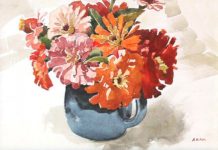
April 30 (UPI) — A painting of a bacchanal — long believed to be a copy of one by artist Nicolas Poussin — has been revealed to be an original by the French painter after a recent evaluation and conservation efforts, London’s National Gallery announced Thursday.
The museum is including the Baroque-style painting, The Triumph of Silenus, in its upcoming exhibit, “Poussin and the Dance.” It will be the first exhibition dedicated entirely to the 17th century painter, who is known for his religious and mythological subject matter inspired by classical antiquity.
“Thanks to the work of the gallery’s curators, conservators and scientists, the painting has been recognized as Poussin’s original. This is a very pleasing outcome of our ongoing research into the gallery’s collection,” National Gallery Director Gabriele Finaldi said.
The Triumph of Silenus depicts a traditional bacchanal — a wild revelry — featuring featuring drunken figures dancing, playing music and otherwise enjoying themselves. Silenus, a companion to the wine god Bacchus, or Dionysus, is shown being held up by fellow partiers, with his leg draped over a tiger.
The painting was among the 38 held by John Julius Angerstein, whose collection formed the foundation of the National Gallery when it was founded in 1824. It was initially believed to be an authentic Poussin, until the 20th century, when experts determined it was a copy.
The painting was one of three Poussins commissioned by Cardinal de Richelieu around the same time, around 1637. The National Gallery also holds The Triumph of Pan, while the third painting, The Triumph of Bacchus, is at the Nelson-Atkins Museum of Art in Kansas City, Mo.
Experts believed the Silenus painting was a copy because its finish wasn’t as fine as the Pan and Bacchus artworks — the varnish was discolored and some of the figures appeared more coarsely painted.
It was also known that at some point before 1741, copies of all three scenes were made and taken to England.
But recent technical analysis and conservation efforts have lead museum experts to believe the Silenus painting is indeed authentic. After removing the discolored varnish, they determined the painting’s palette is bright and the level of detail on the figures matches that of the Pan and Bacchus paintings. The three paintings used similar pigment mixtures and analysis of the canvas determined all three were cut from the same bolt of cloth.
X-ray analysis also showed that there were composition changes made to the Silenus painting during its creation, casting doubt on the claim that it’s a copy.
Francesca Whitlam-Cooper, the National Gallery’s associate curator of paintings 1600-1800, wrote about the new findings in the May issue of Burlington Magazine.
“The three Triumphs Poussin painted for Cardinal de Richelieu play such an important role in the artist’s career: It was on the strength of these works that he was summoned back to France to paint for the king, which is what ultimately led to his being seen as the founder of the French School of painting,” she said.
“Poussin only painted a handful of these riotous dancing scenes, so it is fantastic to have rediscovered this original work in time for the first exhibition of his dance pictures.”






